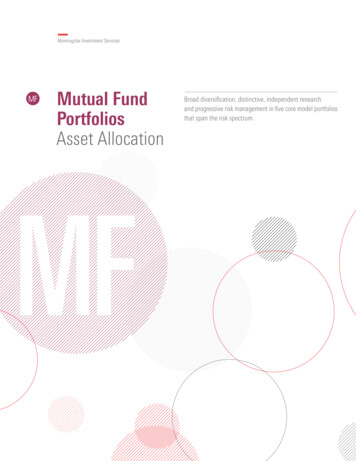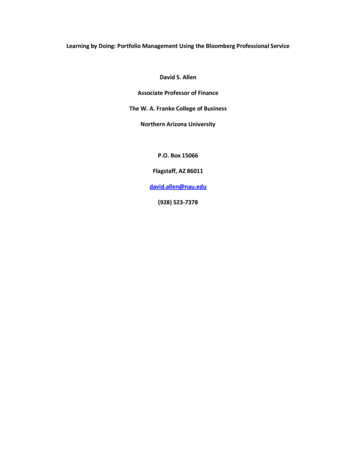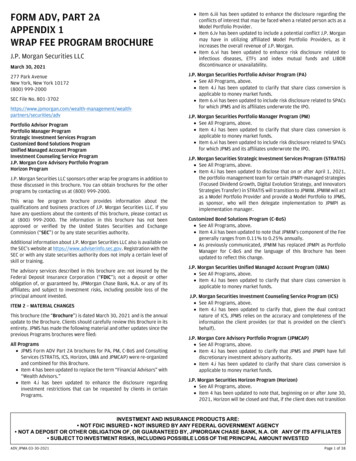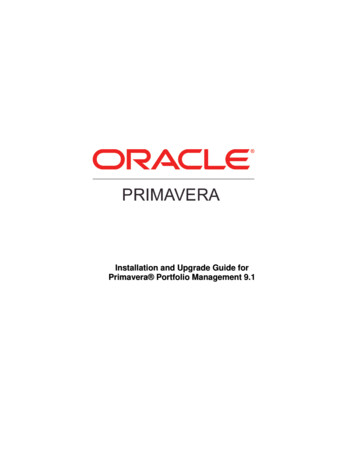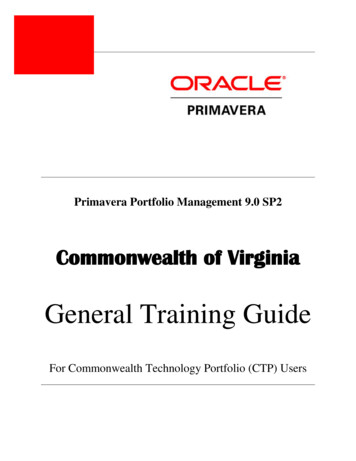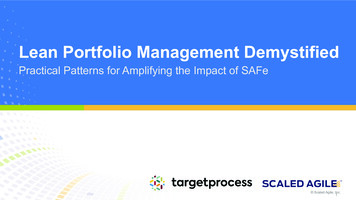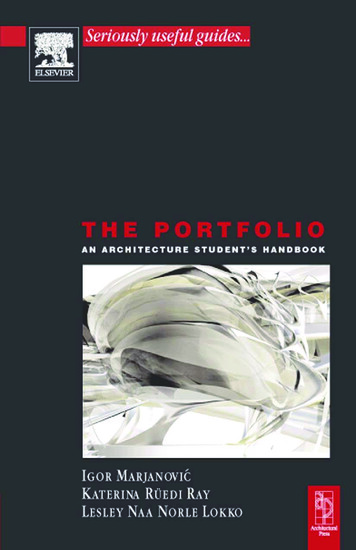
Transcription
Seriously useful guidesThe PortfolioAn Architecture StudentÕs HandbookIgor Marjanovi c,« Katerina RŸedi Rayand Lesley Naa Norle LokkoArchitectural PressAMSTERDAMSAN DIEGOBOSTONHEIDELBERGSAN FRANCISCOLONDONSINGAPORENEW YORKSYDNEYTOKYOOXFORDPARIS
Architectural PressAn imprint of ElsevierLinacre House, Jordan Hill, Oxford OX2 8DP200 Wheeler Road, Burlington, MA 01803First published 2003Copyright 2003, Elsevier Science Ltd. All rights reservedThe right of Igor Marjanovic,« Katerina RŸedi Ray and LesleyNaa Norle Lokko to be identified as the authors of this workhas been asserted in accordance with the Copyright, Designsand Patents Act 1988No part of this publication may be reproduced in any materialform (including photocopying or storing in any medium byelectronic means and whether or not transiently or incidentallyto some other use of this publication) without the writtenpermission of the copyright holder except in accordance withthe provisions of the Copyright, Designs and Patents Act1988 or under the terms of a licence issued by the CopyrightLicensing Agency Ltd, 90 Tottenham Court Road, London,England W1T 4LP. Applications for the copyright holderÕswritten permission to reproduce any part of this publicationshould be addressed to the publishersPermissions may be sought directly from ElsevierÕs Scienceand Technology Rights Department in Oxford, UK: phone:( 44) (0) 1865 843830; fax: ( 44) (0) 1865 853333; e-mail:permissions@elsevier.co.uk. You may also complete yourrequest on-line via the Elsevier homepage(http://www.elsevier.com), by selecting ÔCustomer SupportÕ andthen ÔObtaining PermissionsÕ.British Library Cataloguing in Publication DataA catalogue record for this book is available from the British LibraryLibrary of Congress Cataloguing in Publication DataA catalogue record for this book is available from the Library of CongressISBN 0 7506 57642For information on all Architectural Press publications visitour website at www.architecturalpress.comTypeset, printed and bound in Great Britain
ContentsAbout the authorsvAcknowledgementsviiList of Illustrationsix1IntroductionWhy Make a Portfolio?The Handbook2Getting StartedWhat is a Portfolio?Portfolio DestinationsHow To Get There5518283Design CulturesCultural CapitalAcademic MarketsProfessional Markets Ð How Do You Know This isThe Place for You?International Cultures323234Academic PortfolioThe Portfolio in the AcademyThe Academic NarrativeThe Academic CV, References and Statement of Intent5757616541123841
ivContents5 Professional PortfolioThe Portfolio in the WorkplaceThe Professional NarrativeThe Professional Resume, References and Cover LetterDocumenting Built WorkConstruction Drawings7070707578806 Preparing the Portfolio of WorkSelecting, Recording and Storing Your WorkScanning, Reducing and Reproducing Your Work8282867 The Folio ContainerBuying a Portfolio ContainerMaking a Portfolio Container9191978 Making the Traditional PortfolioGraphic DesignAssembling the Portfolio1021021119 Making the Digital PortfolioDigital vs. ÔTraditionalÕ PortfolioCD RomAcrobat Reader and PDF FilesWeb-based Portfolios11311311812212310 AfterwardsWays of Sending Your WorkAbout the portfolio contributorsIndex127127129133
About the AuthorsIgor Marjanovic« is Adjunct Assistant Professor of Architecture andInterim Director of Undergraduate Studies at the University of Illinoisat Chicago. He has practiced and exhibited widely, including Europe,South and North America. IgorÕs design awards include those fromthe Chicago Architectural Club, the Art Institute of Chicago,Universities UK, and the International Union of Architects (UIA). Hisresearch focuses on travel, hybridity, and the appropriation ofmontage practices in architectural design. He is working on a bookwhich explores the relationship between architectural and cinematicmontage. With Katerina RŸedi Ray he is one of ten selected exhibitorsin the forthcoming architectural exhibition Chicago: Issues for a NewMillennium at the Art Institute of Chicago. Igor studied architecture atthe University of Belgrade, Serbia, the Moscow Architectural Institute,Russia, and the University of Illinois at Chicago, USA. He is currentlyundertaking research for his PhD by Design at the Bartlett School ofArchitecture, University College London, UK.Katerina RŸedi Ray is the Director of the School of Art at BowlingGreen State University. From 1996 to 2002 she was the Director ofthe School of Architecture at the University of Illinois at Chicago. Shestudied architecture at the Architectural Association in London, UKand has a masters and a doctoral degree in architecture fromUniversity College London, UK. She has taught architectural designand theory at the Architectural Association, the Bartlett School andKingston University, UK. She has won various European designawards and she has acted as a visiting professor, critic and lecturerat numerous European and north-American architecture and art
viAbout the Authorsschools. Her publications include Desiring Practices: Architecture,Gender and the Interdisciplinary, Desiring Practices: Artists andArchitects and The Dissertation: An Architecture StudentÕs Handbook.She is currently working on several books, including Chicago isHistory, Bauhaus Dream-house: Identity Formation in ModernistDesign Education, and 133 and Rising: African-American WomenArchitects. With Igor Marjanovic« she is one of ten selected exhibitorsin the forthcoming architectural exhibition Chicago: Issues for a NewMillennium at the Art Institute of Chicago.Lesley Naa Norle Lokko is Course Director of the MArch. programmein Cultural Identity, Globalization and Architecture at the BartlettSchool of Architecture, University College London, UK. Lesley studiedarchitecture at the Bartlett, UCL where she also taught for two yearsbefore moving to the USA to teach at Iowa State University and atthe University of Illinois at Chicago. On her return to the UK in 2000,she taught at Kingston University and was the Academic Leader atUniversity of North London before re-joining the Bartlett in 2002. Sheis the author of White Papers, Black Marks: Race, Culture,Architecture and has published and lectured widely on the subject ofrace, cultural identity and diasporic cultures and how these informarchitectural and spatial production. She is a founder member ofThirdSpace, an organization which aims to provide a forum for architects and academics interested in issues of architecture and postcolonial/cultural studies. She has also just written her first novel(Sundowners, due for publication January 2004) and now divides hertime between academia and fiction writing.
AcknowledgementsWe wish to offer our sincere thanks to Dr Jonathan Hill for his assistance at various times in this project. We also wish to thank thevarious tutors and professors who have worked with the authorswhose portfolios appear in the book, as well as, most importantly theauthors themselves. In addition, we wish to thank Anthony Marty forhis design and technical assistance relating to the web page accompanying the book, and James McKay for technical assistance with themany digital glitches we encountered. We are also sincerely gratefulto Alison Yates and Elizabeth Whiting, of Elsevier, for their consistently helpful advice. Finally, and most importantly, we wish to thankJasna Marjanovic« and Roger Ray for their unfailing support in amyriad ways throughout all stages of this project.Igor Marjanovic«Katerina RŸedi RayLesley Naa Norle Lokko
This Page Intentionally Left Blank
List of illustrationsChapter 22.1 Christopher Ciraulo, Osaka International Design Competition2.2 Christopher Ciraulo, Undergraduate work, University of Illinois atChicago, IL, USA2.3 Jeffrey Morgan, Block 37: New Media Center, Chicago, IL, USA,Schiff Award, 20012.4 Jeffrey Morgan, Block 37: New Media Center, Chicago, IL, USA,Schiff Award, 20012.5 Anthony Max D. Marty, Undergraduate work, Illinois Institute ofTechnology, Chicago, IL, USA2.6 Nicholas Smith and Katrin Klingenberg, Collage2.7 RED (A. Ramirez and D. Stojanovic), Portfolio2.8 Igor Marjanovic,« Kremlin Redesigned (together with UrosVukovic« and Marija Milinkovic),« Moscow Architectural Institute,Russia2.9 Igor Marjanovic,« Kremlin Redesigned (together with UrosVukovic« and Marija Milinkovic),« Moscow Architectural Institute,RussiaChapter 33.1 Christopher Ciraulo, Light Pavilion3.2 Zane Karpova, Shi-ga Museum, SOM Travelling Fellowship2002, Schiff Award 20023.3 Zane Karpova, Shi-ga Museum, SOM Travelling Fellowship2002, Schiff Award 20023.4 Ivan Subanovic,« Aristotelous Axis, Thessalonica, Greece,International Competition, second prize (together with MilanMaksimovic,« Karolina Damjanovic,« Zorica Petkovic)«
xList of Illustrations3.5Ivan Subanovic,« Bus Terminal, Lazarevac, Serbia, NationalDesign Competition, second prize (together with MilanMaksimovic,« Maja Kusmuk, Zorica Petkovic)«3.6 Marjan Colletti, The Professional Architect3.7 Clare Lyster, Monaghan3.8 Clare Lyster, Monaghan3.9 RED (A. Ramirez and D. Stojanovic),« Portfolio3.10 RED (A. Ramirez and D. Stojanovic),« A Project for Beirut3.11 Mark Chalmers, RChapter 44.1 Matthew Springett, Manhattan Pig Farm, diploma portfolio, theBartlett School of Architecture 1997/98, London, UK, The RIBASilver Medal Winner, 19984.2 Matthew Springett, Manhattan Pig Farm, diploma portfolio, theBartlett School of Architecture 1997/98, London, UK, The RIBASilver Medal Winner, 19984.3 Matthew Springett, Manhattan Pig Farm, diploma portfolio, theBartlett School of Architecture 1997/98, London, UK, The RIBASilver Medal Winner, 19984.4 Matthew Springett, Manhattan Pig Farm, diploma portfolio, theBartlett School of Architecture 1997/98, London, UK, The RIBASilver Medal Winner, 19984.5 Christopher Ciraulo, Undergraduate coursework at the Universityof Illinois at Chicago4.6 Christopher Ciraulo, Digital Media concentration coursework4.7 Jeffrey Morgan, Intermodal Train Station, Mendrisio, Switzerland4.8 Jeffrey Morgan, Intermodal Train Station, Mendrisio, Switzerland4.9 Dr Jose Gamez, Principal Investigator and Jeff Hartnett, CoInvestigator, Las Vegas Research ProjectChapter 55.1 Clare Lyster, Tower House5.2 Rahman Polk, Success and Independence Network5.3 Mark Chalmers, The Pig, diploma portfolio, Kingston University,London, UK5.4 Mark Chalmers, The Disney Store5.5 Anthony Max D. Marty, Burnham Prize Competition5.6 Ryan Knock, Warehouse Mixed-Use Conversions5.7 Nicholas Smith and Katrin Klingenberg, Practice image grid
List of IllustrationsxiChapter 66.1 Anthony Halawith, Adaptive Restaurant Design, M.Arch. thesisproject, University of Illinois at Urbana-Champaign, IL, USA6.2 Anthony Halawith, M.Arch. thesis project6.3 Anthony Halawith, Adaptive Restaurant Design, M.Arch. thesisproject, University of Illinois at Urbana-Champaign, IL, USA6.4 Jeffrey Morgan, Digital Cinema Studio, London, UK6.5 Matthew Springett, Manhattan Pig Farm, diploma portfolio, theBartlett School of Architecture 1997/98, London, UK, The RIBASilver Medal Winner 19986.6 Igor Marjanovic,« Chicago Townhouse (together with PetarTomicic)6.7 Igor Marjanovic,« Chicago Ð Floating City, Chicago ArchitecturalClub Design Competition, third Prize (together with Vuk Vujovic)«Chapter 77.1 Erik Heitman, Architectural Portfolio, Second Year, B.Arch.Programme, University of Kansas7.2 Erik Heitman, Architectural Portfolio, Second Year, B.Arch.Programme, University of Kansas7.3 Erik Heitman, Architectural Portfolio, Second Year, B.Arch.Programme, University of Kansas7.4 Erik Heitman, Architectural Portfolio, Second Year, B.Arch.Programme, University of Kansas7.5 Matthew Springett, Manhattan Pig Farm, diploma portfolio, theBartlett School of Architecture 1997/98, London, UK, The RIBASilver Medal Winner 19987.6 Matthew Springett, Manhattan Pig Farm, diploma portfolio, theBartlett School of Architecture 1997/98, London, UK, The RIBASilver Medal Winner 19987.7 Andrew Gilles, portfolio container7.8 Andrew Gilles, portfolio container7.9 Andrew Gilles, portfolio container7.10 Andrew Gilles, rŽsumŽ and business card holder7.11 Anthony Max D. Marty, portfolio7.12 Anthony Max D. Marty, portfolio
xiiList of IllustrationsChapter 88.1 Clare Lyster, Smart Curtain8.2 Clare Lyster, Smart Curtain8.3 Katrin Klingenberg, Daniel Szwaj, Hubertus Hillinger, Pier 428.4 Christopher Ciraulo, Life Long Learning Center8.5 Marjan Colletti, M.Arch. portfolio, the Bartlett School ofArchitecture, London, UK8.6 Igor Marjanovic,« The Hybrid Bridge, M.Arch. thesis project,University of Illinois at Chicago, UIC SOM Award8.7 Igor Marjanovic,« The Hybrid BridgeChapter 99.1 Marcosandmarjan, Portfolio Studio, London, UK9.2 Marcosandmarjan, Portfolio Studio, London, UK9.3 Anthony Halawith, digital portfolio no. 19.4 Anthony Halawith, digital portfolio no. 29.5 Ryan Knock, CD cover no. 1 for the digital portfolio9.6 Ryan Knock, CD cover no. 2 for the digital portfolio9.7 Ivan Subanovic, M.Arch. thesis project (together with MarcelOrtmans, I Yu, Markus Ruuskanen), Design Research Laboratory, Architectural Association, London, UK9.8 Ivan Subanovic,« B.Arch. thesis project, University of Belgrade,Serbia, Chamber of Commerce Award, 20009.9 Christopher Ciraulo, 3D Softimage renderings9.10 Igor Marjanovic,« Digital Gallery 1100, Digital Media Institute,University of Illinois at Chicago9.11 Igor Marjanovic,« Digital Gallery 1100, Digital Media Institute,University of Illinois at Chicago
1IntroductionWhy Make a Portfolio?A carefully wrought portfolio of work will be the single most importantrecord and outcome of your architectural education. The major part ofyour education is always going to be the design of buildings asexecuted through drawings, models and other kinds of visual representation, and your portfolio records the ideas, the processes and theresult of your work as a designer in the architecture studio as well asin other visually oriented classes. It can also contain other kinds ofinformation, from your professional work in an architectural office, toyour creative work in related artistic disciplines, your built work if youhave construction experience, and your written work if that is animportant part of your educational process. It is a document with manyfunctions and will therefore take different shapes depending on thesituation for which you need it. If it is well considered and crafted itwill certainly open many doors for you Ð to further study, to differentareas of work in the architectural profession, and quite possibly workin related fields. You will also need it to get teaching positions inacademia, or in secondary (UK) or high school (USA) education. Itcan also help you win prizes and scholarships while you are on yourway.Whichever purpose it needs to serve, your portfolio is your passportand your visiting card, through which you introduce yourself to thenew worlds you wish to enter and by which your value isestablished and compared to others. Very importantly, it is also adocument through which you make a contribution to how we
2The Portfoliounderstand architecture; it is your chance to clarify and share whatyou believe and aspire to, and to present new ideas, techniques,observations and experiences, mainly to others but sometimes justto yourself.The HandbookThis handbook provides a guide to the whole process of designing,making and sending out or presenting a portfolio. It explains carefullywhat to do, how to do it, when to do it, and what the major pitfallsare to avoid when making a portfolio. Each university and architectural programme does, of course, have its own rules and requirementsfor a portfolio. Architectural offices also vary in what they like to seein a portfolio. Sometimes these requirements are explicit, andsometimes they are less tangible. Whichever the case, you arestrongly advised to check everything said here with what differentinstitutions and offices expect. It is also important for you to understand that sometimes the advice we will offer you may differ from thatgiven by your professors or colleagues in an architectural office. Thisis because the architectural discipline is becoming more and morepluralistic in its ideas and cultures, and architectural portfolios necessarily reflect that pluralism. Even if it were once possible, there is nolonger a single type or format of portfolio that will fit all contexts.Instead you will need to make choices depending on the destinationor design culture for which the portfolio is intended. Nonetheless, ifyou follow the guidance in this book, and if you add to it your ownintelligent and rigorous creative efforts, you should go on to producea portfolio of the best possible standard for the different situations inwhich portfolios are needed.The book, following this introduction, is divided into five chapters.Chapter 2 Getting Started outlines the essential ideas behind aportfolio, the kind of occasions for which you need to prepare different portfolios, different kinds of specialization in architecture, and howyou might adjust the message of your portfolio to the audience thatwill be looking at it.Chapter 3 Design Cultures explains why portfolios differ in form andcontent in different design cultures, and how they represent culturalvalue. It gives some practical advice about how to find out about thedesign cultures of different architectural schools and practices, andhow to understand some regional and global differences.
Introduction3Chapter 4 Academic Portfolio then focuses in detail on how toprepare an academic portfolio, what it needs to contain, and how toformat an academic CV, statement of intent, references and letters ofrecommendation.Chapter 5 Professional Portfolio examines in detail how to preparea professional portfolio, covering portfolio form and content, rŽsumŽ,references and the cover letter, with special emphasis on the selection and presentation of built work.Chapter 6 Preparing Material offers practical advice on selecting,recording and storing work, as well as scanning, reducing and reproducing it.Chapter 7 The Folio Container is about making the physical portfolio container itself, whether this is bought or made specially for theoccasion.Chapter 8 Making the Traditional Portfolio gives advice about theorganization and layout of images and text in the portfolio for a smallselection of different portfolio types.Chapter 9 Digital Portfolio focuses on the advantages and disadvantages of the digital portfolio, as well as different formats such asCDs or web pages, and outlines some basic technical issues relatedto the digital production of images and animations.The final chapter, Chapter 10 Afterwards gives advice about howbest to send your portfolio, whether in physical or digital format, andalso suggests useful ways to keep updating your portfolio.Throughout this book, we are very proud to say, you will also findexamples of pages from outstanding portfolios previously completedby architecture students. Some of these are prizewinning portfoliossubmitted to the Royal Institute of British Architects in London for itsinternational Presidents Silver and Bronze Medal student competition.Others are award winners in the Skidmore Owings and MerrillTravelling Fellowship, the most important architectural competition forUSA students. Other portfolios helped their authors to obtain work inarchitectural practice, in architectural education, or in related designdisciplines such as graphic design or advertising. You will thereforefind not only pertinent advice but also instances of how architecturalstudents have tackled the portfolio with extremely successful results.We have tried to point out individual strategies used by the contributors in their portfolios in captions below the images at the end of eachchapter. These groups of images will give you a quick visual introduction to some of the issues covered in each chapter. However, youwill still need to read each chapter itself to get a balanced overviewof the issues it covers.
4The PortfolioAccompanying this book is a website that shows the full portfoliosof the contributors to this book. In many instances it also includes thecontributorsÕ rŽsumŽs or curriculum vitae so that you can get an ideahow to format those for yourself. We encourage you to go to thewebsite to get the overall impression of each portfolio, as individualpages certainly do not do justice to the creativity, thoughtfulness,technical ability and hard work that have gone into the making of eachof these portfolios. The website url is http://www.theportfolio.org.ukThe website will also give you an idea of the diversity of formatsand approaches which you can explore as you prepare your portfolio.We hope that it will help and encourage you to make your portfolio adocument of which you will be proud and which will represent you wellin the broader world of architecture and design.
2Getting StartedGetting started involves understanding the most basic aspects of a portfolio and its preparation. Getting started also involves understanding whyyou need a portfolio and what it is for. This chapter will help you getstarted, outlining some of the issues to help tailor your portfolio tovarious destinations in academia and practice.What is a Portfolio?A portfolio of work is defined in different ways depending on the situation. There are different portfolios for different occasions. Obviouslyyou will have one kind of portfolio at the end of your second year asan undergraduate student and another kind when you have finishedpost-professional studies. More importantly, when you come to makeyour portfolio at the moments in your life when you want your academic or professional career to develop or change, you will mostprobably make a different portfolio to suit where you would like tobe heading.However, all these different kinds of portfolios will have one thingin common. They will contain your work in a format that will make iteasy for the portfolio to be transported physically and digitally to manydifferent situations. The most normal format for a portfolio most closelyresembles a book. It can be a small book (A4 or 81Ú2" 11" (210 279mm)) which is easy to mail, or it can be a large book, almost like acollection of paintings (A1 or 24" 36" (594 841 mm)) which youtake with you to interviews. Increasingly, portfolios are digital and canbe sent in CD format or exist as a website. With a digital portfolio you
6The Portfoliowill have more freedom to play with the format but will also be relyingon someone else to understand how to access it.Remember, it is still easier for most people to turn pages than tonavigate links and understand graphic and animation software.All these formats will have one thing in common. The fact that theportfolio is a travelling document, that its function and meaning maychange depending on the context, and that your career may hang onit, means that it has to be tough, beautiful, clearly organized, veryeasy to understand and even easier to use.Whatever the context for which you need the portfolio, or the phaseof your career, there are basic rules about the portfolio that you shouldremember. They are: e first rule for making a portfolio is to keep every piece of work youproduce in the studio, in the office and in related visual, technical, orpractical areas. Taking care of your work is the most important professional activity you will ever do. Although you may not see the connection now, later on you may need to show some of your exploratorysketches for a design project because a particular Diploma Course orgraduate programme may want to see how you think through drawing.Or you may need construction photographs because a particular officemay want to see that you already have some site experience, andthat you know how to recognize good from bad construction. So, getinto the habit of scanning or photographing hand-drawn work ormodels at regular points during the project. A good time to do this isimmediately after a review or jury Ð it gives you time to reflect on thetotality of the work, and if you do it well, it will make you proud ofwhat you have done. Make sure you date the work Ð memory alonecan play tricks later on. Buy a plan chest (UK) or a flat file (USA) foryour flat work. Take photos when you go on site and date them. Keepan album or digital record of photos. Get extra copies of constructiondrawings that you produced or co-produced. Save all your digital filesand make sure you get CD copies of digital work so that your work
Getting Started7is always backed up outside as well as inside your computer. Dating,scanning and filing work is good to do when you need a break fromcreative work. This will create a large volume of work, so think aboutits ease of storage and transportation. As you are designing, whetheryou are making sketches, drawings or models, use consistent sizesor plan to assemble work into consistent formats at regular intervalsÐ it will be much easier to transport and store. Having a thousandpieces of work of different sizes will make your life really difficult inthe long run.However you choose to do it, remember: when in doubt, beconsistent and DOCUMENT!EditingThe second rule for making a portfolio, however, is knowing what itis not. The portfolio is definitely not an archive of every piece of workthat you have ever done. At a basic practical level you will not havethe time and money to reproduce all that work, you will not want topay vast amounts of money to mail it, and certainly the people whowill be looking at your portfolio will not have time to look at everythingyou have done. In a professional situation, especially if there is aneconomic recession and greater competition for work, very often if youdo not capture in the first few pages of your portfolio the imaginationsof the people who are looking at it, they may not even get all the waythrough your portfolio. That means you will need to edit the portfolioitself to include only the best, the most engaging and sometimes themost provocative, work. In addition, you will need to remember thatthere are also differences between portfolio expectations in differentcountries. In the USA the portfolio you will most likely use to apply forentry into graduate school will probably be mailed in and be smallerin size and volume whereas in the UK, where you often take originalwork or large print-outs to a personal interview, the portfolio can belarger in size and contain more work. In the UK you may be able toexplain work in person whereas in the USA you will need to makesure your portfolio will say everything you want your audience toknow. Finally, you will need to edit your work because your portfoliowill have to be as clear as possible about your ideas and experience,and should only contain work that shows your strengths.The second rule for making a portfolio is therefore EDIT, EDIT,EDIT!
8The PortfolioMessageThe third rule for making a portfolio is to know exactly what you wantto show and why. As an architectural student you will need a portfolio for different occasions. What you decide to edit out and what youdecide to keep in the portfolio will depend on how you want to beseen and what the portfolio is for. What kind of a message are youtrying to get across? By this we do not mean a verbal message,although you will almost certainly want to use words to emphasizeyour focus in your work. A portfolio message should clearly communicate what kind of architectural interests and skills you have. Forexample, the portfolio you will use to apply to graduate school mayemphasize your creativity and ability to work through challengingideas and unusual forms, whereas a portfolio you use to apply for aprofessional job in an office may need to include constructiondrawings, site photographs and schedules to emphasize your technical competence. Even more specifically, if you are applying to agraduate school because you want to join that schoolÕs specializationin community architecture or activist practice, you will need to selectdocuments from your vast archive or work which show both a breadthof creativity and your special interest in community architecture. Youmight include photos of work you have done in community gardens,essays you have written on collaborative practices or public art, andhighlight those projects you did as an undergraduate which show thatyou have an ability to respond to the needs of others. If you are applying to a school where you wish to pursue design and robotics, say,make sure that you include in your portfolio any moving objects youhave made, or research essays and reports on the subject.Occasionally this may mean that you might have to make a newproject just for the portfolio. If your education to date has not providedyou with the kind of work you think you will need to go to the nextphase of your career, you may need to take extra evening classes ormake additional drawings to show just how committed you are to thedirection you want to pursue. For example, if you have a very technical undergraduate portfolio and you want to get into a diploma orgraduate school that is very artistic, you may need to take an eveningclass in sculpture or drawing. Making a portfolio means you aremaking an identity for yourself, through the work that you selectto show.The third rule for making a portfolio therefore is to be veryclear about THE MESSAGE.
Getting Started9AudienceAs you can see, the message of your portfolio will change dependingon the next intended phase of your career. The most important thingto remember is that although you, the author of the work, and yourmessage, may remain the same during a particular phase of yourcareer, the audience for your work may change dramatically. In manycases you yourself may want to use the portfolio to change yourenvironment Ð sometimes dramatically if you are thinking of changingcountries or
7.4 Erik Heitman, Architectural Portfolio, Second Year, B.Arch. Programme, University of Kansas 7.5 Matthew Springett, Manhattan Pig Farm, diploma portfolio, the Bartlett School of Architecture 1997/98, London, UK, The RIBA Silver Medal Winner 1998 7.6 Matthew Springett, Ma


